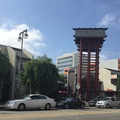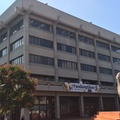I once heard an apocryphal story from a community activist who had worked in Little Tokyo for a long time. It went something like this. As an elderly Japanese American woman was walking down the streets of Little Tokyo, rolling her groceries in a cart, she saw a pair of White men walking towards her. It was clear that the three of them and the roller could not all fit on the sidewalk. Although she realized that someone would have to step into the street, she resisted an initial urge to step aside and continued walking, forcing one of the men to step off the curb. Explaining her actions, she said, “In any other neighborhood I would have stepped aside, but not Little Tokyo. Little Tokyo is our neighborhood.”
Though perhaps a relatively insignificant story, the bachan’s assertion that “Little Tokyo is our neighborhood” has resonance even for me, a Yonsei who grew up visiting Little Tokyo almost weekly. For many Japanese Americans in Southern California, Little Tokyo occupies an important emotional space; many feel a sense of ownership over the enclave regardless of how far from it they live. One Japanese word used to describe this sense of belonging and connection is furusato—“ancestral home” or “home village” in English—which conveys a sense that Little Tokyo always has been and always will be a Japanese American space.
Although the Japanese American presence in Little Tokyo dates back to the 1880s, the neighborhood was never uniformly Japanese. During the World War II incarceration period, its population was almost entirely African American, and the enclave was renamed Bronzeville. During the 1960s and ’70s, its brick four-story hotels hosted a large Latino community alongside the aging Issei. Throughout its history, other Asian American groups such as Chinese Americans and Filipino Americans have been consistently present.
The presence of these other groups historically and currently complicates an imaging of Little Tokyo as “our neighborhood.” Additionally, the current dwindling of Japanese American retail presence in the community with the arrival of chain establishments such as Spitz, Demitasse, and American Apparel raises similar questions. And yet, in spite of all this, Little Tokyo endures as furusato—in planning documents, in news coverage, and of course in the minds of Japanese Americans, manifesting in big moments such as Nisei Week and Obon festivals, and smaller ones like the elderly woman’s refusal to step off the curb.
Little Tokyo, however, was not always seen this way. In the immediate postwar period (1945–70), the neighborhood represented a segregated prewar housing market and ethnic economy; it was a place the Nisei wanted to escape as they tried to rebuild their lives. In the words of Katsumi Kunitsugu, a prominent Nisei columnist: “...after the war, it became pretty apparent that the Nisei weren't going to stay in Little Tokyo. And then of course, with the Civil Rights Movement and all that, you could pretty much find housing anywhere that you could afford, instead of having to just settle for something in Little Tokyo…”1
How and why Little Tokyo became the spiritual center for a generation of Japanese Americans reflects a complicated history of racism, assimilation, and enduring historical trauma in the 1960s and ’70s. It was only during this time, Little Tokyo’s redevelopment period (1969–80), that the enclave’s centrality to the community was reestablished through a multi-million dollar public-private investment program. This period saw the transformation of Little Tokyo’s low-lying brick buildings and low-income residential hotels into modern community institutions such as the Japanese American Community and Cultural Center (1980), Higashi Honganji (1976), and Little Tokyo Towers (1975).
But while redevelopment produced many of the key institutions of the Southern California Japanese American community, Sansei resistance to the destruction and displacement that came with redevelopment’s most controversial project, the New Otani Hotel (1976), provided a renewed emotional investment in Little Tokyo’s historical legacy. Facing the potential loss of the enclave’s heritage, it was the Sansei who most clearly and passionately articulated the importance of Little Tokyo as an enduring symbol of the Japanese American experience.
The Sansei impetus to re-center Little Tokyo reflected their unique social position and experience of race in Southern California. Although they were raised during a time when housing and economic opportunities were opening up to Japanese Americans, they were still racialized as “other” during a time when there was no vocabulary for affirming a position of “otherness”; the term “Asian American” was still unheard of. The sense that Japanese Americans were not “true Americans” was a pervasive form of racism that structured the way they understood their identity.
Sansei youth interviewed by political scientist Don Nakanishi in 1973 remembered being blamed by their peers for the bombing of Pearl Harbor. Others complained about being seen as foreigners in their own country: “If you have a camera and go to Disneyland they’ll think you’re a tourist.” Another summed up their frustrations as follows: “Americans tend to think of Japanese Americans as Japanese, which means that you could have come over yesterday for all they know.”2 These perceptions even manifested in otherwise reputable print media; in a 1973 article describing the redevelopment struggles, Civic Center News opined, “Most of us round-eyed Americans tend to consider Japanese Americans to be closer in spirit to their Japanese cousins than to their American brothers.”3
This racial encoding of Sansei bodies as “other” and “foreign” clashed with the strong integrationist mindset of their parents and the whiteness of school curricula. One of my interviewees reminisced about the difficulty of knowing oneself when the history taught at school only celebrated the accomplishments of “White America.” Though his middle school was majority Asian, Latino, and Black, Mike Murase recalled, “The history is all about the accomplishment of White America and the westward expansion and all the inventor[s] and this other stuff. And very little was taught to us about the Black experience, slavery or Native Americans or Asian Americans—nothing about Asian Americans.”4 As another Sansei put it, “Young Sansei like me felt void of a sense of history at a time when history defined identity.”5
Sansei lacking a sense of history in school would not find it at home as many Nisei tried to forget the experience of incarceration.6 Instead, the Nisei encouraged their children to assimilate into American society. As Japanese American National Museum (JANM) curator Karen Ishizuka said, “They [the Nisei] believed that sustained model citizenry would provide retroactive evidence that it was ‘they’ [the U.S. government]...and not ‘we’ who had been wrong.”7
Notes:
1. Katsumi Kunitsugu interviewed by Leslie Ito for the REgenerations Oral History Project in Los Angeles, California, on April 22, 1998. Japanese American National Museum.
2. Don Toshiaki Nakanishi, “The Visual Panacea: Japanese Americans in The City of Smog,” Amerasia Journal 2, no. 1 (October 1, 1973): 38.
3. “Little Tokyo Redevelopment Rekindles Fire,” Civic Center News, December 11, 1973. From Frank F. Chuman Papers, Box 560, Folder 7.
4. Transcript, Mike Murase Oral History Interview, August 2015 by Samuel Mori.
5. Janice Tanaka, When You’re Smiling: The Deadly Legacy of Internment (Visual Communications, 1999).
6. Karen L. Ishizuka, Lost and Found: Reclaiming the Japanese American Incarceration (Chicago, University of Illinois Press, 2006), 6.
7. Ishizuka, Lost and Found, 7.
* This article is an except from Samuel Mori's senior thesis, “Saving Furusato: Japanese American Imaginings of Community, Culture, and History through the Little Tokyo Redevelopment Projects,” submitted to the Department of History, Swarthmore College, on April 29, 2016. It was revised for publication on Discover Nikkei.
© 2016 Samuel Mori






